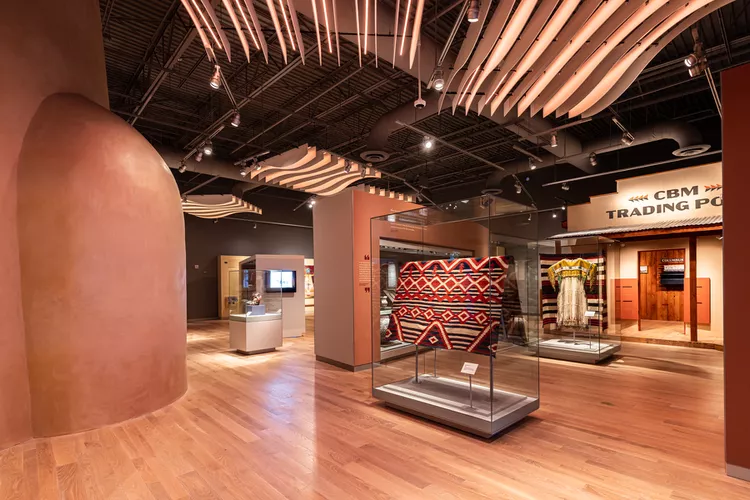Exploring the Exhibition at MIAC
Get inside the mind of a curator to make the most of your museum visits.

Walking swiftly through an exhibition, casually browsing the collections and skimming the labels is how many of us experience a museum. However, many elements and nuances of exhibition design also tell a part of the museum’s story. Taking note of details such as the color of the walls, architectural features, and the manner in which items are displayed can deepen your understanding of the work presented.
Exhibition Design
The newly renovated “Here, Now, and Always” (HNA) serves as the core exhibition at the Museum of Indian Arts and Culture (MIAC) in Santa Fe. This institution collaborates with Native Americans across the Southwest to present their stories. In addition to its collection of approximately 650 objects, the layout, design, and architectural components work cohesively to illustrate a narrative. “Native people, particularly Native people of the American Southwest, are here, and they are contemporary and will always be here,” says Tony Chavarria, curator of ethnology at MIAC. He emphasizes that “Their art and cultures are a vital part of the American experience.”

Visitors begin with a walk through a 55-foot-long tunnel, named the Emergence Tunnel. Cast in cool blue light and accompanied by sounds of thunder and rain, the tunnel acts as a transitory space. “It prepares visitors for a change in expectations and perspectives,” explains Chavarria. This architectural feature symbolizes many Native American creation myths whereby communities have emerged from another Earth into the current world known as the Fourth World.
Installation Techniques

The layout of a museum is integral to creating a smooth experience, allowing visitors to orient themselves and transition effortlessly through various sections without disruption. The Emergence Tunnel opens into a circular space, a shape chosen to reinforce the exhibition’s theme. Titled “Cycles,” this area serves as the hub, featuring four displays of objects linked to childhood, adulthood, marriage, and rites of passage. Originally conceptualized as an angular space, its sharp edges were rounded to create a more organic form. This shape visually cues visitors to reflect on time as a cyclical concept, incorporating life’s changes and transitions.
“With the redesign of ‘Here, Now, and Always,’ we wanted to create a welcoming space where visitors feel comfortable rather than intimidated,” explains Lillia McEnaney, assistant curator at MIAC. The design aims to reflect Native people in the exhibition strategically.

Objects are displayed throughout the exhibition in various ways—from wall mountings to ground displays and pedestals—to enhance their impact and narrative. The height at which items are presented plays a vital role, encouraging deeper connections with visitors. For instance, HNA’s collection of nine pinch pots made by Native American children is displayed at a lower height, offering younger visitors a sense of connection to the ancestral children who created them. This intentional positioning fosters the idea that art is both universal and accessible to all.
Color and Aesthetic Choices

Color selection is often an overlooked aspect of an exhibition. The colors of a museum’s walls not only enhance aesthetics but also create a cohesive narrative that supports the displayed objects. HNA’s walls feature shades of blue, earthy terra-cottas, and pale yellows, complemented by intentional lighting. “These bright colors convey that this isn’t just a historic exhibition; it represents the contemporary vibrancy of the Southwest’s people,” explains McEnaney.

Museums, while filled with objects preserving history, culture, and heritage, serve as a starting point for deeper exploration rather than the endpoint of a visitor’s learning journey. “Here, Now, and Always” serves as an entry point, encouraging visitors to think about Indigenous perspectives and communities, explains McEnaney. Beyond the museum’s doors, the quest for knowledge can continue by exploring available resources, such as artist interviews or online catalogs.
By recognizing certain design elements and architectural features, museumgoers can critically interpret the narrative of an exhibition. Consequently, approaching museum visits with curiosity and an open mind enhances the learning experience, enabling deeper insights and appreciation for the artistry displayed.





